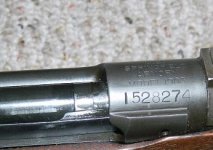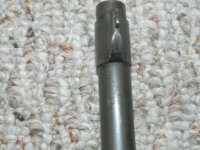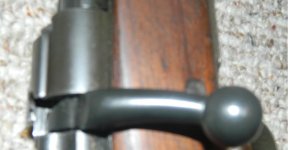I've been a Springfield 03 fan for more than 50 years...and I can tell you, they can provide an endless supply of questions. Authenticity is always a question, but rarely the serial number. Most questions are in regard to various parts...are they original or replacement.
It must be understood that probably better than 90% of them were rebuilt, often several times over the course of their service lives, and untold numbers were sent overseas as "lend-lease" or outright gifts to our allies. CMP returns from overseas, most particularly Greece, have again muddied the water. Several of my 03's share this heritage and I treasure them almost as much as my "never" imported ones.
Below, I've added several pics of some of my serial numbers. Of them all, I am absolutely sure of only two, 1389506, a bono fide "National Match" 1903, documented, and 3510, a .22lr Springfield. For the first, I have the sales receipt from Camp Perry in the early '30's. For the 2nd, I am confident through hours of research. I post the pics for your comparison....note the imprint of the "1"...noticeably similar to that of your rifle...even on my National Match and the vintage M2. Note that the "1" extends, infinitesimally, below the other serial numerals.
Note too the punch mark on some of the "receiver shelves", (that extension on the right side that allows add'l support for the bolt race), and the piercing for the gas relief port. In my view, yours is the same. Some Springfield collectors have opined that the punch mark indicates that the rifle, most particularly, the receiver has been re-barreled. It may be that or it may be that the punch mark was a part of the hardness testing process, after the brittle receiver controversy came up.
As to the safety of your particular '03, that you'll have to decide for yourself. You may find Brophy's epic, "The 1903 Springfield Rifles" invaluable...and a bit confusing...it's a 616 pg. tome! Crossman's, "The Book of the Springfield" as well as Campbell's, "The 03 Era" are less lengthly but good references as well. My only reservation is the barrel date. Rebarreled rifles in my collection, have later dates...some just a few years and one in 1944. Not saying that a '13 barrel could not have been added to your receiver, but I've not encountered one.
That said, you rifle's receiver was one of the last produced, if authentic, and the parts bins may have been getting low at that time. Who's to say that a '13 barrel wasn't down there on the bottom. Remember, US Marines went ashore on Guadalcanal carrying both low numbered and high numbered "03 Springfields. They did their own rebuild on rifles, some in Philly, some at Springfield, and it could have been one of theirs.
As to the safety of "low numbered Springfields", I have found reference in one of the above books, to inspecting the recoil lug's forward guard screw hole. In a low number Springfield with the dreaded '"brittle" receiver, that hole and it's extension below the lug, was sometimes chipped.
I once owned a low numbered Rock Island '03 with its original barrel that was superbly accurate with any good bullet and powder combination. Even with that antiquated 'ladder' sight, I have 2-3", 200 yd groups from my then 40 year old eyes. The lug and the forward guard screw seat were not chipped and I felt confident in its strength. Nevertheless, I did not try to magnamize it, and shot good 2700 fps match loads with good target success. But in case you mis-read me, I am not advocating anyone shooting a low number Springfield...I
am relating references for further study, and my own experience.
Here at the pics: A cpl thoughts: Note the alignment of numbers, the location of the gas relief hole under the 3rd digit from the right, the punch marks on the receiver shelf, and the even quality of the nomenclature as it was stamped on the curved receiver surface, i.e. there is no 'thinning' at the top and bottom of the letters. For your info., only the National Match has not been refinished...the other two have but at some arsenal using an industrial process, not your local gunsmith shop...
Hope this helps...Rod
Below, is a documented National Match '03, most likely produced in 1931 and no doubt rebuilt after the matches at Perry. Note the "1" in the serial number and its similarity to your rifle's number. Also note the punch mark and that the serial number is not centered exactly.
This pic, below, is of a "Greek" return, 03 just a few thousand from your receiver. Again note the "1" in the serial number and its similarity. Again there is the punch mark.
Below, is another "high" number. Note the "1" again, centering of the serial number etc. Another "Greek" return...
This last pic shows the receiver of an M2 .22lr Springfield from the early '30's. I include it for the appearance of its serial number. Note the "1" again.








